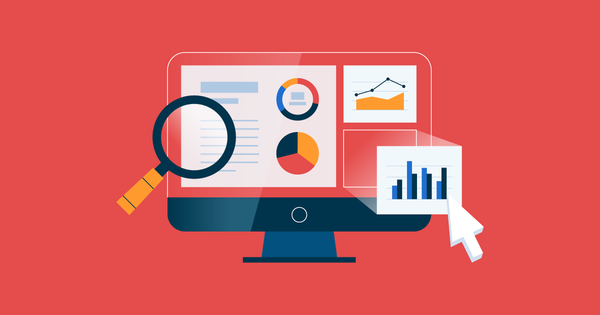Business intelligence (BI) software is a data analysis system that allows users to access, analyse and share information about their business. In turn, they can use performance metrics to make important business decisions every day. But where does self-service business intelligence software come into play?

With self-service BI tools, users don’t need to be a data scientist to operate it. On a daily basis, business users can:
- Define parameters
- Analyse data
- Generate reports.
Without self-service analytics programs, companies must depend entirely on data professionals to interpret and extract information on their behalf. However, with a BI tool, companies can simplify and speed up this process.
According to Gartner, data analysis will move further toward the forefront of transformational business strategies for 90% of companies in the coming years.
Contents
What is the difference between traditional BI and self-service BI?
The difference between traditional BI and self-service BI is that the latter offers democratised access and usability of the tool.
When traditional BI tools appeared on the market, they required a complex IT structure—in addition to high maintenance costs and the need to invest in specialised workers. Not all companies have the resources for this structure. As a consequence, this meant the systems were mostly limited to large companies and multinationals.
With the emergence of self-service BI software, more small and medium-sized businesses can benefit from business intelligence. Partly, this is because of the simplified interface, ease of deployment, and a lower cost to adopt the software.
To break it down further, here are the main pros and cons of using a self-service BI tool:

What are the advantages of adopting self-service BI?
The advantages of self-service BI is the ease of accessibility for any user to take the platform and start using the data according to their needs. With the system, users can filter, analyse and extract data with its accompanying insights and learnings, without depending on specialists.
Here’s a self-service bi example within a typical business today: A marketing team could use it to track new leads, including where they came from, and use this data to define future lead nurturing strategies. This planning can happen with the speed required to keep up with the fast-paced marketing industry, without having to wait on other departments to chip in.
Lastly, these tools are cloud-based so users can access information from anywhere. This is useful for remote teams, or those not based in a company office. Not only does it allow companies to be more flexible and productive, but it also helps them to save on infrastructure costs.
What are the limitations of self-service BI?
Like all technology, self-service BI software doesn’t come without its limitations. But the good news is that most of these are not associated with the performance of the tool itself, but rather with the tool being misused.
Common pitfalls & how to avoid them:
Below are the main pitfalls to be aware of:
Lack of planning
First and foremost, if you are implementing a BI tool, you should have a clear purpose or strategy for its use. This is so you have a clear direction when requesting and analysing data, and can use the data most advantageously for your business.
In a context in which you may not yet have a clear strategy established, you’ll likely accumulate a lot of reports that say the same thing. Often, this is difficult to spot because the reports look different by showing varied visuals and graphs, for example. However, the information is essentially the same, which risks confusion when interpreting the information and hinder productivity.
Lack of internal organisation
While a key benefit of the software is its usability ease, companies need to ensure they keep the system organised for any new users that join. This avoids any confusion if, for instance, someone departs the company and leaves a series of reports which aren’t clear to the team inheriting them.
By keeping the tool well configured, companies also control which content is public or private This provides an important information security measure to help avoid the sharing or misuse of confidential data.
Lack of update
Updating the tool frequently helps with the accuracy of the data. If regular checks aren’t carried out, the software may emit erroneous data. The day-to-day running of the software doesn’t require heavy involvement from the IT team, but they should check in every so often to ensure the tool is still performing as they want it to.
Examples of self-service BI tools for you to consider for your company
Below is a selection of the best self-service BI tools for a range of expertise—we’ve included a full methodology of how we chose these tools at the bottom of this article.
1. Power BI

Power BI is a tool from Microsoft which provides interactive visualisation and analytics features. It doesn’t require deep knowledge in BI, making it suitable for a range of professionals needing access to business data. Microsoft regularly provides optimisations thanks to the feedback it receives in the market, offering new features that meet the ongoing demands of businesses.
2. Tableau

Tableau’s key advantage is its visualisation of data, regardless of the type and format of this information. The tool is compatible with most forms of data and offers the possibility to connect with large volumes of information for bigger requests.
3. OriginPro

OriginPro provides users with the flexibility to create graphics and a wide range of size, resolution and format options to display data. Users of the platform say it is easy to use because it has a straightforward interface.
4. SiSense

Users of SiSense say the platform is simple and easy to use, especially for those who are not data experts. As well as this, users highly rate the platform’s customer support service.
Methodology for the tool list
The tools selected for this article had to have an overall rating of at least 4.5 /5. They also required more than 100 user ratings in the Capterra directory. Also, the tools could not have a rating lower than 4/5 in the below requirements:
- Practicality
- Customer service
- Resources and quality
- Price ratio.
This article may refer to products, programs or services that are not available in your country, or that may be restricted under the laws or regulations of your country. We suggest that you consult the software provider directly for information regarding product availability and compliance with local laws.



